Planning out a marketing strategy is no easy feat. But turning these concepts into content is where the biggest challenge lies for 44% of marketing teams.
It doesn’t matter if you’re a startup trying to get a foothold in your industry, or a long-established name with an extensive marketing department – even the best-laid plans can fall apart if you can’t keep up with content creation.
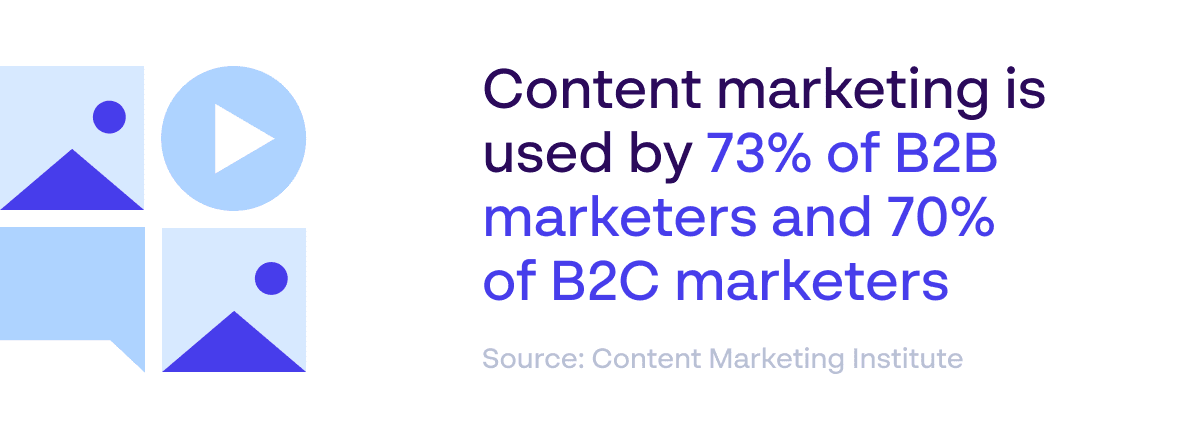
To meet the rapidly growing demand for high-quality, on-brand assets, a recent study revealed that 69% of digital marketing departments rely on one or more third-party agencies to create the content they need to build trust, attract leads and drive success.
While the relationship between an agency and an internal promotional team can often reap wonderful results, utilising these specialist skills for day-to-day content creation can come with a high cost. At a time when marketing budgets continue to fall across the board, this is a burden that is far from sustainable.
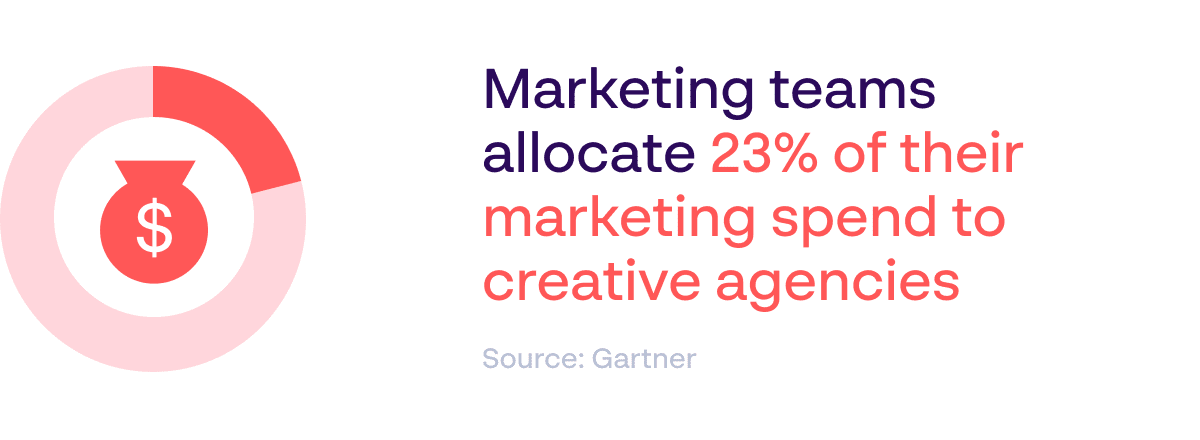
Even those blessed with the privilege of in-house design and development teams find it difficult to maintain pace with the rising call for marketing content. When creatives are pulled away for vital tasks and projects, their focus on the day-to-day churn of content can slip, leading to broken campaigns or drops in quality and consistency.
With all this in mind, how do you empower your marketing teams to deliver the masses of branded collateral you need to reach new and existing customers, aid lead generation, and achieve the long-term goals laid out by your leadership teams?
It all starts with self-sufficiency. Below we explore what this means, the challenges involved, the practical steps you can take to promote independence in your company, and the benefits associated with this approach.
What is a self-sufficient marketing team?
A self-sufficient marketing team operates independently, efficiently managing all aspects of campaigns without relying on frequent support from outside the business.
This means that, with the right skills, tools and resources, independent marketing teams can meet the increased demand for content throughout your organisation, creating collateral, executing campaigns and adapting to changes to drive positive results.
However, self-sufficiency doesn’t necessarily mean zero involvement from design agencies or external partners. Instead, it’s about reducing the dependence on these groups for the daily demands that drive campaigns and keep marketing content rolling at a consistent pace.
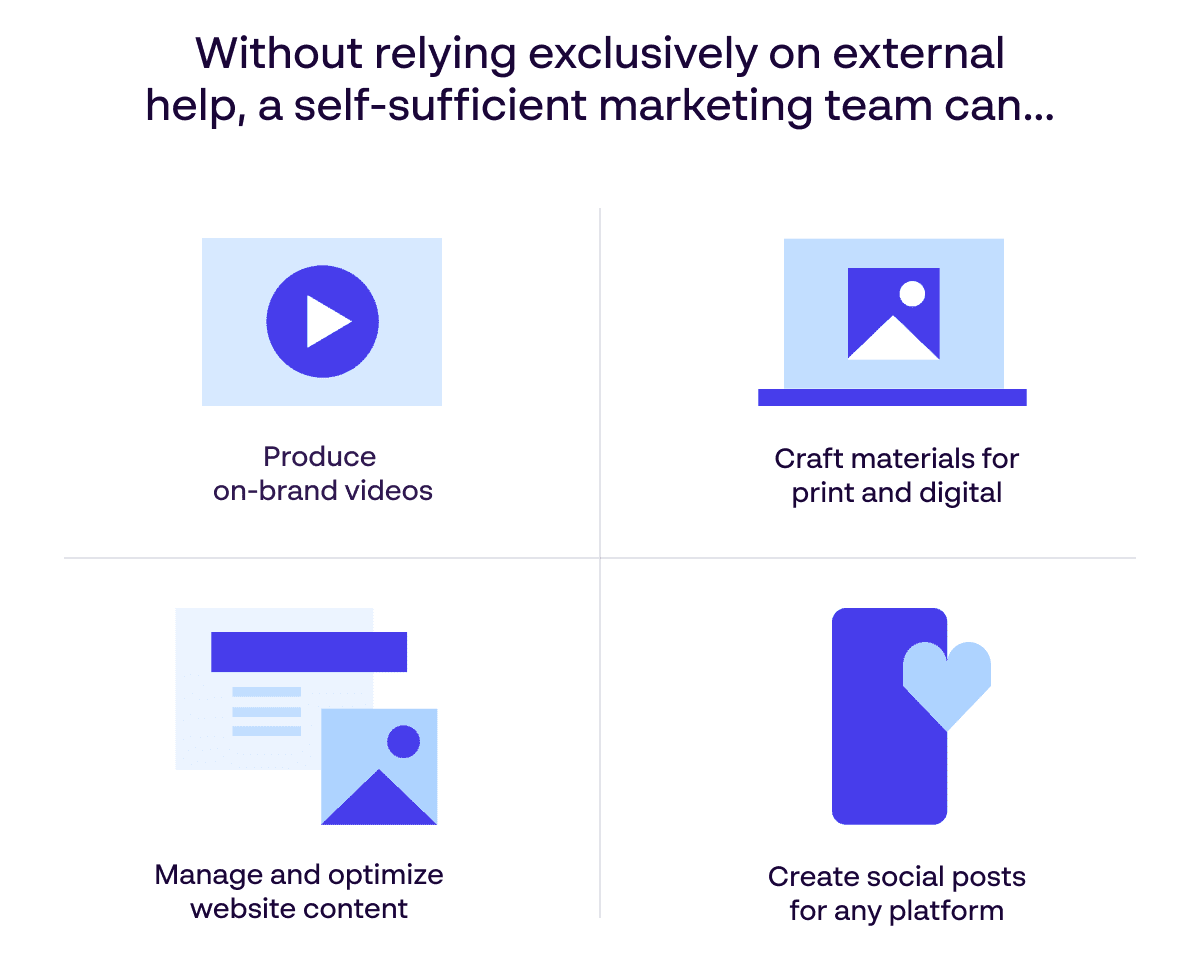
The greatest barriers to self-sufficient marketing
Thanks to rising customer expectations, the prominence of personalisation and a growing fight for audience attention, the burdens on marketing communication teams are heavier than ever.
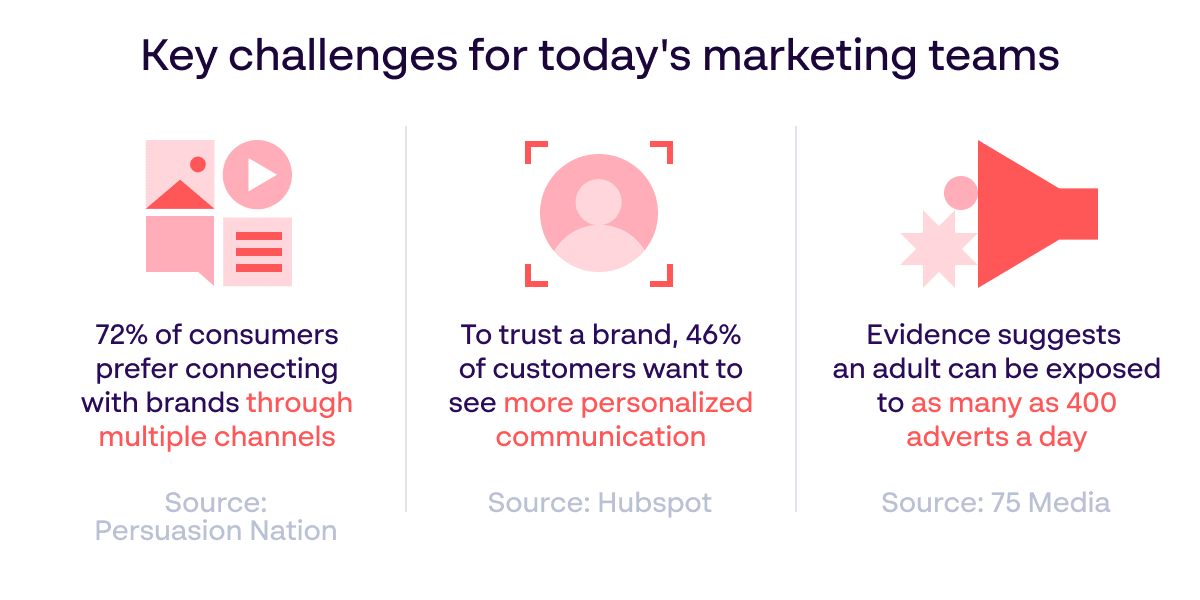
Even if these challenges aren’t hampering the capacity and capabilities of your content supply chain right now, two-thirds of marketing professionals expect the demand for promotional materials to grow between 5 and 20 times in the coming years.
To make sure your marketers are prepared for this future, they need to be independent and equipped to handle content creation themselves. However, making this a reality is easier said than done.
Quality content is in high demand
When you consider how multichannel marketing has become the standard for the majority of brands, and that more than 50% of companies use at least 8 channels to interact with their customers, you can start to see how insufficient capacity is such a prevalent problem for professionals in this space.
Coupled with the predictions for even higher levels of collateral being required to make an impact, and it’s immediately obvious the sheer scale of this challenge.
Put simply, your team needs a lot of content going out to make an impression. Content that not only covers multiple touchpoints, but is also completely consistent and able to deliver genuine value to your audiences.
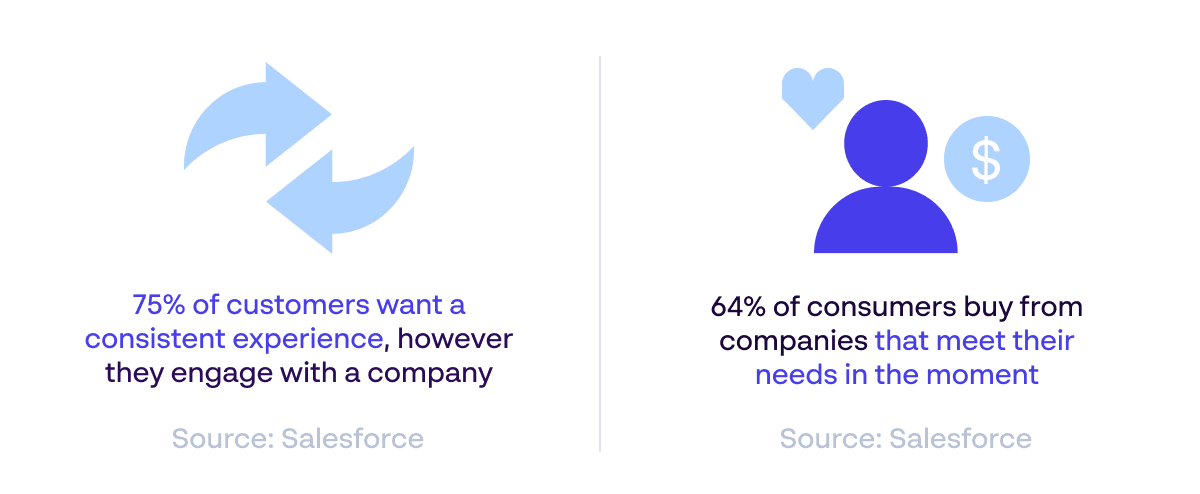
With each platform having its own additional specifications, such as file formats, aspect ratios and sizes, creating the various types of content your marketing teams need to get campaigns off the ground is one of the biggest hurdles to self-sufficiency.
Production processes can get crowded
It’s rare for a single person to be responsible for the end-to-end creation of an asset; this presents a key problem for true marketing independence.
Whether a piece of collateral first requires strategic input from the department head or the assistance of copywriters and graphic designers along the way – being reliant on so many individuals from start to finish leaves room for mistakes, oversights and inconsistencies.
Organising these moving parts is essential to mastering the art of marketing self-sufficiency. Getting it wrong can delay projects, strain resources and impact your business’s bottom line. Furthermore, crowded content supply chains tend to be slow and cumbersome, making it harder for your brand to tap into timely marketing opportunities.
To independently produce the pieces of content that guide your brand to long-term success, it’s crucial to streamline the important parts of your content creation ecosystem.
Localisation can weigh down operations
If you have a presence in multiple territories, you know your identity must be more than consistently presented. Resonating with regional audiences demands content that is localised to specific markets.
In practice, that could mean updating imagery to respect the cultural sensitivities of a certain group or producing collateral in the local language of your audiences.
These added layers of complexity go beyond extensive research and adaptation. In some cases, localising collateral means crafting entirely new designs, which can further strain the finite time and resources available to your self-sufficient marketers.
If you want to establish independence throughout your marketing department, your team must have the tools to tackle the immense burden that localisation brings to their day-to-day operations.
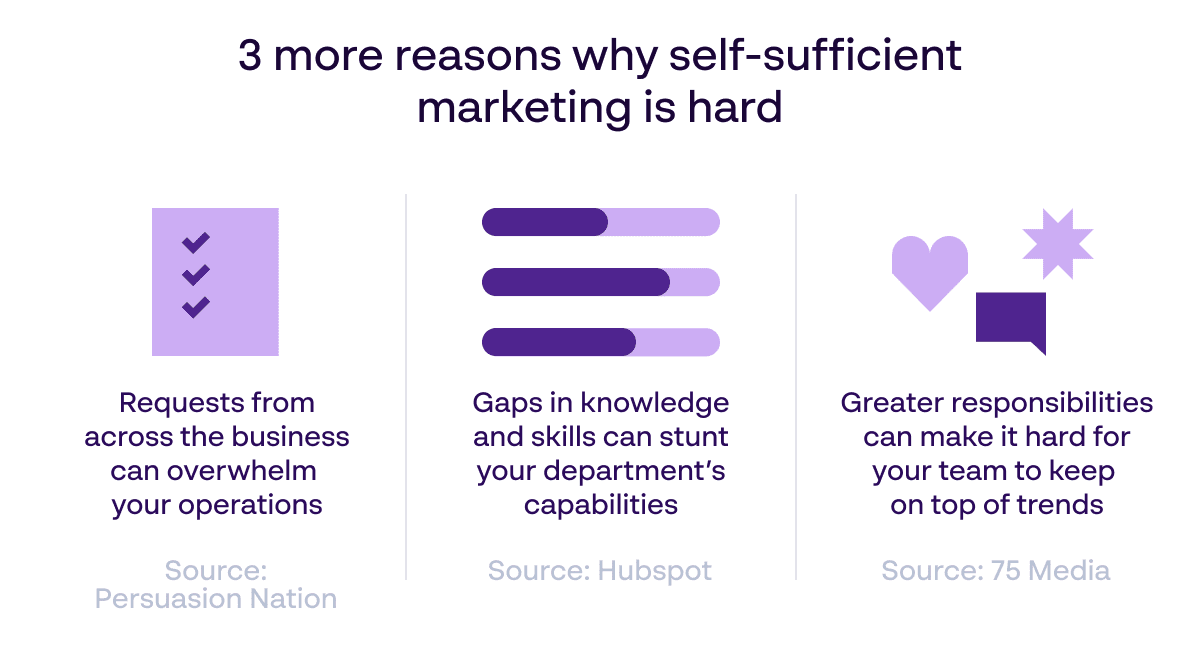
6 tools and techniques to unlock true marketing self-sufficiency
Despite the challenges involved, taking a more independent approach to marketing throughout your organisation can lead to meaningful long-term cost savings, greater brand consistency and true marketing scalability.
But how do you enter this era of self-sufficiency? We’ve rounded up 6 essential solutions and strategies to get you there.
1. Rely on template libraries
Template libraries are an integral part of any self-sufficient communication department, giving marketing management and support teams the ability to produce high-quality content rapidly.
This means there’s no need to build materials like social media posts, infographics and email campaigns from scratch over and over again. With a library of digital design templates by your side, this technology helps solve the problem of speed and consistency in your content production pipeline.
Templates can also democratise the design and delivery process, meaning your colleagues no longer need to rely on the costly services of an agency, or wait for a gap in your designers’ schedules to get creative. Couple this with easy on-brand asset creation tools, and you’re well on your way to building a truly autonomous marketing department.
2. Develop clear brand and style guidelines
Few things can disrupt the independence of your marketing operations as unclear brand guidelines can.
With no clarity on what elements should and should not be incorporated across your collateral, the job of content creation becomes increasingly difficult, forcing your marketing department to bring on outside help or rely on rounds of amends from higher-ups – outcomes that can slow production to a crawl and undermine your team’s self-sufficiency.
Solving this problem requires comprehensive digital style guidelines; a foundation from which your marketers can produce consistent, on-brand marketing materials across any channel, enabling them to take full ownership of this important task.
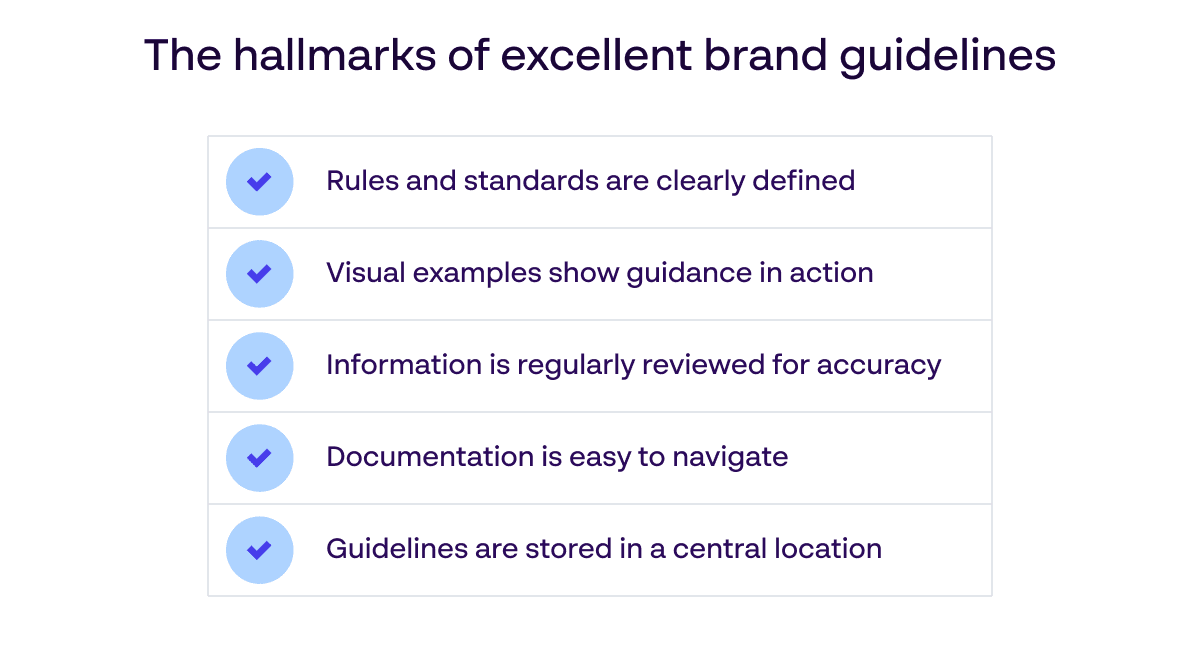
3. Establish a centralised brand portal
Another essential piece of technology to inspire self-sufficiency in your marketing is a brand hub or brand portal.
These platforms act as a single, central ‘home’ for all of your brand’s key building blocks, from style guides and colour charts, to tones of voice examples, exemplar assets and more. Everything your marketing professionals need to understand and represent your brand accurately in one destination.
But the advantages don’t end there. By placing all this information in one, easy-to-reach digital place, a brand portal can help ensure your people are spending less time finding the information they need, and more time managing your brand in-house, helping your campaigns go to market faster.
4. Implement robust marketing automation tools
Carrying out the entire content production and marketing pipeline in-house involves a lot of work, especially if this is something you currently rely on third parties for at the moment.
Marketing automation platforms can streamline many of the more menial tasks to ease the pressure on your teams’ workload. Be it aggregating customer interactions, posting on social or coordinating email marketing campaigns – the more you can automate, the more self-sufficient you become.
This does more than free up the capacity of your marketing creatives. It allows them to focus on higher-impact activities that demand strategic thinking, so they can deliver greater long-term value.
With automated workflows to reduce the strain of your routine operations, your team can function with greater autonomy, better adapt to market trends, and become a more self-sufficient unit.

5. Use AI-powered content production tools
As we mentioned earlier, the call for content isn’t just becoming greater; audience expectations are also rising. Meeting the pace and quality today’s customers are looking for demands agile, intelligent technology, and marketing AI can be a game-changing addition to your content production workflows.
Whether that means employing AI writing tools like GrammarlyGO to help you proof content and produce long-form blog posts, or ideation-focused software such as ContentShake AI to generate data-driven ideas for your content plan – this technology can turn your marketers into fast, multidisciplinary creators.
With the ability to do more themselves, your marketers can deliver a steady flow of content without completely depending on in-house creatives or third-party agencies, enhancing their overall self-sufficiency and productivity.
However, while AI can be a powerful tool, it’s important to remember that it works best as a complement to your marketing professionals rather than a replacement for them. Prompts still need human input and oversight to achieve the human-centred quality key to long-term success.
6. Commit to regular training and upskilling
Finally, when you invest in regular training for your marketing teams, you equip them with the skills to handle more tasks in-house.
Be that mastering new tools or honing creative traits, enabling your professionals to become better at what they do reduces their reliance on external resources.
Plus, upskilling your employees allows them to stay sharp in the rapidly-evolving landscape of digital marketing; knowledge they can draw from to enhance the overall performance of their ongoing campaigns.
After all, it helps if your marketing team not only understands how to accomplish their role, but also has the confidence to innovate and tackle the challenges that stand in their way.
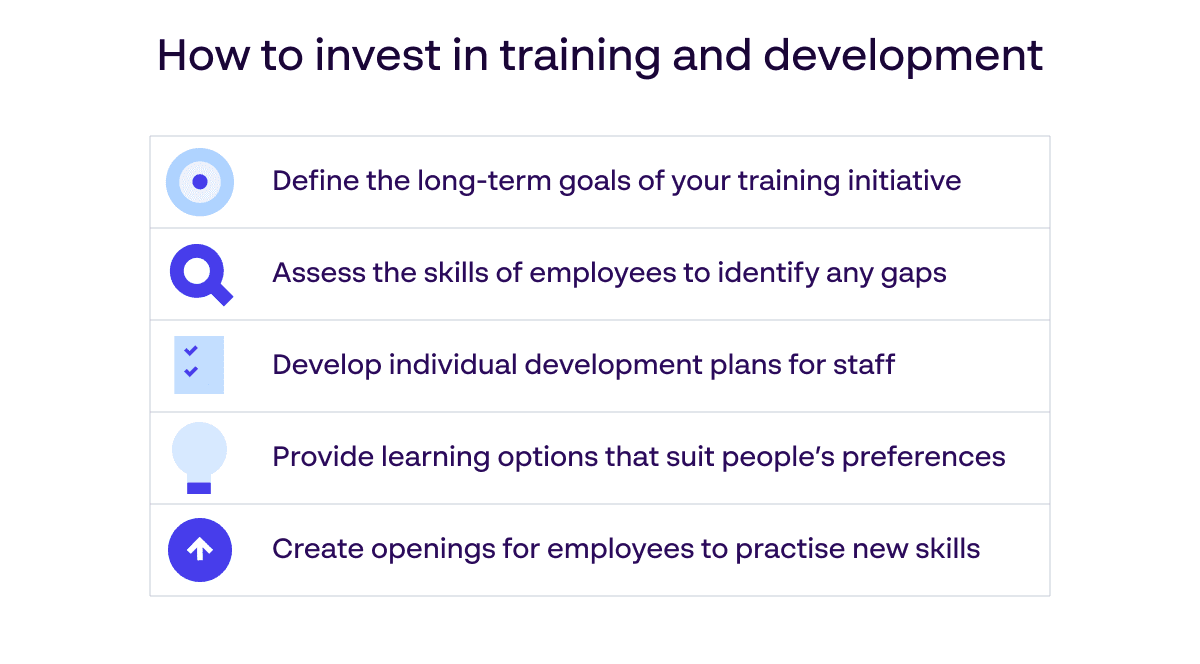
What are the benefits of self-sufficient marketing?
When you empower your marketing teams to become increasingly self-sufficient, you unlock the ability to produce content, reach target audiences, build trust and achieve objectives without relying solely on outside assistance.
As you can imagine, reducing the costs associated with outsourcing marketing can be a great way to maximise your promotions’ bang for their buck, and allocate resources that can be used to drive your business toward greater success.
Handling content creation in-house also opens the door to increased marketing agility. In practice, that means your marketers can react to timely opportunities and data-driven feedback much quicker.
Plus, with consistency the foundation of brand trust, another advantage self-sufficient marketing can bring to the table is wall-to-wall brand alignment. With everything handled internally, there are fewer opportunities for errors and inconsistencies to sneak into a customer’s journey.
Involving fewer external stakeholders in the marketing pipeline can also lead to effective communication. This promotes inter-department collaboration and allows proposed strategies to take flight far quicker.
Perhaps most importantly, self-sufficiency gives your team members a strong foundation from which to scale their operations. As well as priming your brand for the content-rich future ahead, this approach allows your departments to more readily adapt to your ever-evolving business needs.
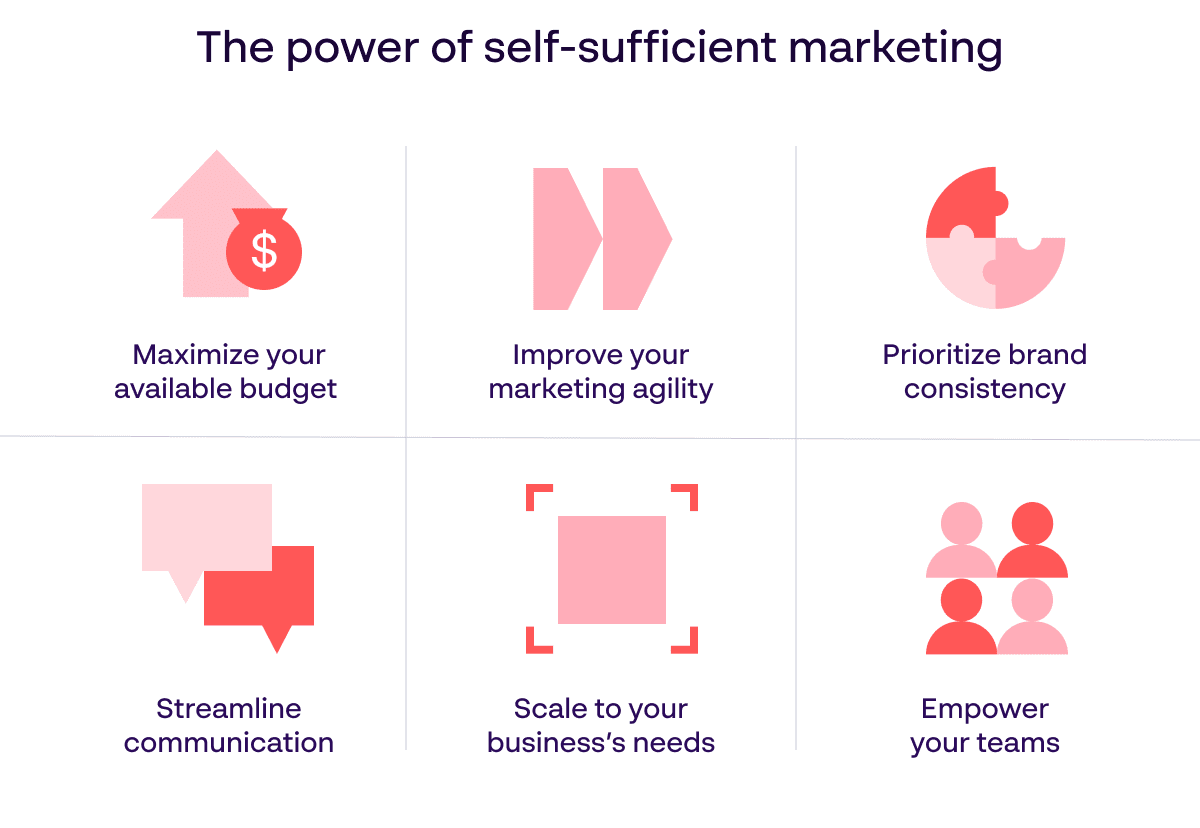
Successful, sustainable marketing begins with a self-sufficient approach
Content is the lifeblood of every campaign. It’s what reaches your target audiences and entices them to become repeat customers.
But keeping up with the ever-growing demand for collateral is hard. Many teams rely on the assistance of third parties to deliver the quality and scale required, even as marketing budgets continue to decline – an unsustainable combination for even the most well-prepared brands.
As you’ve discovered, self-sufficiency gives you a competitive advantage in your ongoing efforts to engage, inspire and delight your consumers. By harnessing the tips and tricks we’ve showcased in this article, you can unlock the shackles on your staff and make content creation a seamless, swift and structured process across your departments.
By striving towards self-sufficiency, you free your company from unwanted bottlenecks and breakdowns in communication and guide it towards a future of sustained, effective performance.
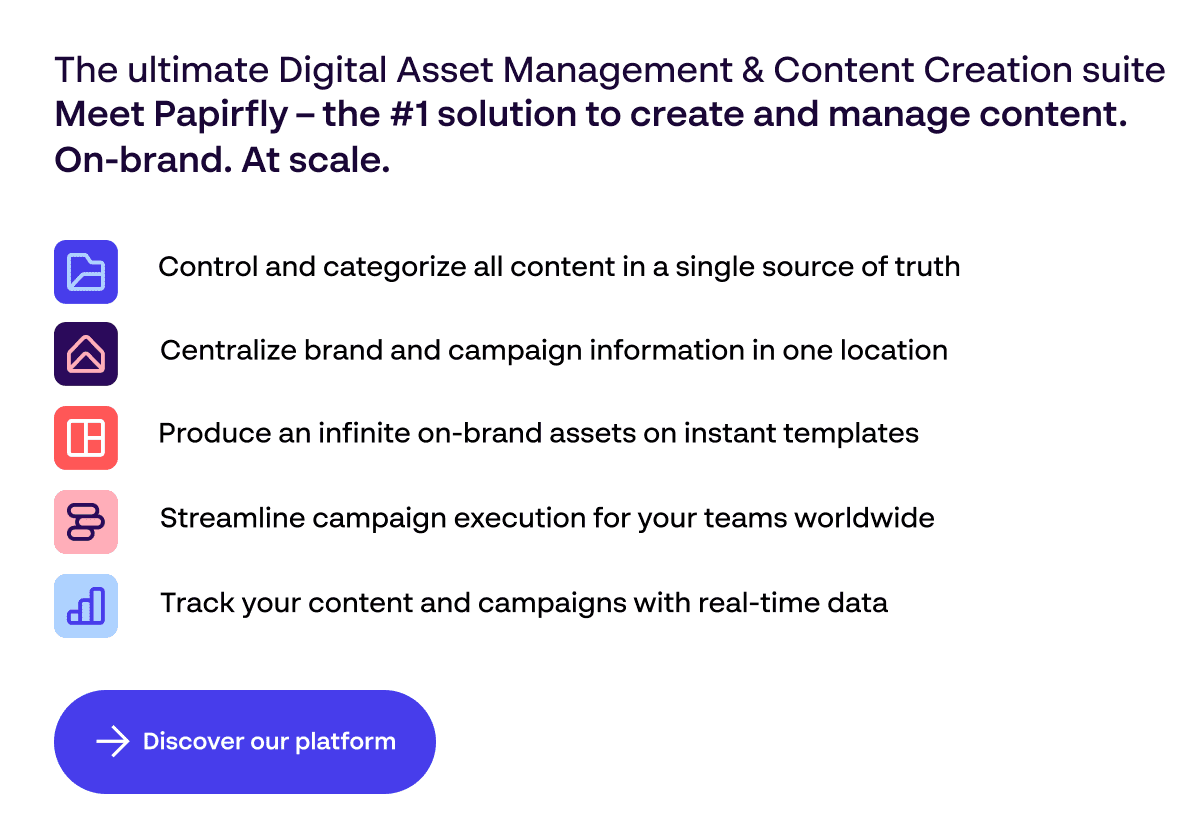
Table of contents:
